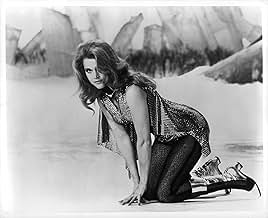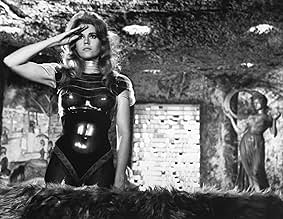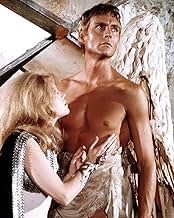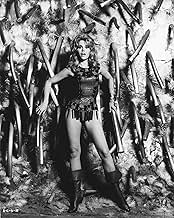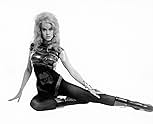CALIFICACIÓN DE IMDb
5.9/10
40 k
TU CALIFICACIÓN
Barbarella, un astronauta del siglo cuarenta y uno, se propone encontrar y detener al malvado científico Durand Durand, cuyo Rayo Positrónico amenaza con traer el mal de vuelta a la galaxia.Barbarella, un astronauta del siglo cuarenta y uno, se propone encontrar y detener al malvado científico Durand Durand, cuyo Rayo Positrónico amenaza con traer el mal de vuelta a la galaxia.Barbarella, un astronauta del siglo cuarenta y uno, se propone encontrar y detener al malvado científico Durand Durand, cuyo Rayo Positrónico amenaza con traer el mal de vuelta a la galaxia.
- Dirección
- Guionistas
- Elenco
- Premios
- 1 nominación en total
Véronique Vendell
- Captain Moon
- (as Veronique Vendell)
Franco Gulà
- The Suicide
- (escenas eliminadas)
- (as Franco Gula)
Honey Autumn
- Bald Handmaiden at Sogovian Court
- (sin créditos)
Silvana Bacci
- Girl in Sogo
- (sin créditos)
Opiniones destacadas
If you're looking for a cult classic, they don't come much stranger than sexed-up and super-silly BARBARELLA, the peculiar tale of an intergalactic secret agent (Jane Fonda) sent to a rebel planet to find a mad scientist named Duran Duran (Milo O'Shea.) Directed by Fonda's then-husband Roger Vadim, the film is less concerned with creating a coherent storyline than it is in finding inventive ways to strip Fonda of her already skimpy outfits.
In this it is remarkably successful, and Fonda actually has both enough sex appeal and round-eyed innocence to carry the thing off, emerging as something like a Barbie doll; John Philip Law strikes a similar note as the sexy but equally innocent "angel" Pygar. The designs are 1960s psychedelic with as many Freudian twists as the film's makers can come up with, and when all is said and done you can't help but roll your eyes in amusement.
True enough, BARBARELLA was probably much more entertaining back in the days LSD, and indeed one might read the entire thing as an acid trip time machine. No one in the cast takes the film very seriously, and neither should you; when all is said and done it has all the depth of a pancake, not so much funny as merely amusing and appealing to a very high-camp sensibility. But as cult movies go, it ranks right up at the top. Give a party and show it on a double bill with FLESH GORDON! Gary F. Taylor, aka GFT, Amazon Reviewer
In this it is remarkably successful, and Fonda actually has both enough sex appeal and round-eyed innocence to carry the thing off, emerging as something like a Barbie doll; John Philip Law strikes a similar note as the sexy but equally innocent "angel" Pygar. The designs are 1960s psychedelic with as many Freudian twists as the film's makers can come up with, and when all is said and done you can't help but roll your eyes in amusement.
True enough, BARBARELLA was probably much more entertaining back in the days LSD, and indeed one might read the entire thing as an acid trip time machine. No one in the cast takes the film very seriously, and neither should you; when all is said and done it has all the depth of a pancake, not so much funny as merely amusing and appealing to a very high-camp sensibility. But as cult movies go, it ranks right up at the top. Give a party and show it on a double bill with FLESH GORDON! Gary F. Taylor, aka GFT, Amazon Reviewer
Take a kaleidoscope to your eye, let it dwell, at the night sky, after a while you just might see, colours conjured, so wild and free, imagination is the game, often wildly insane, a pinch of salt may be required, but this is elegance inspired.
It's as daft as it's delirious, and to some mildly nefarious, but Jane Fonda is a star, and this is an early car, that delivers all her talents, all the things that make her balance, with many tongues in many cheeks, it's most always, worth a peek.
A wonderfully wild ride through a universe long since forgotten, and seldom revisited, that indelibly reminds us of a a time when boundaries needed breaking, and often were.
It's as daft as it's delirious, and to some mildly nefarious, but Jane Fonda is a star, and this is an early car, that delivers all her talents, all the things that make her balance, with many tongues in many cheeks, it's most always, worth a peek.
A wonderfully wild ride through a universe long since forgotten, and seldom revisited, that indelibly reminds us of a a time when boundaries needed breaking, and often were.
Just what were they on? "Barbarella" is one of those sixties films (the Beatles vehicle "Help!" is another) which, although it makes no explicit references to the decade's drug culture, nevertheless leaves the indelible impression that the director, the scriptwriter, the set designer, the costume designer, the cameramen and most of the cast were under the influence of mind-expanding drugs throughout the entire shooting period.
I first saw the film at university in the early eighties when a student film society organised a screening. Interest in it at that time may have been aroused by the release in 1980 of "Flash Gordon", another ultra-camp science fiction film which was undoubtedly influenced by it, and by the fact that one of the leading British pop groups of the era had called themselves Duran Duran in homage to their origins in a now-defunct Birmingham nightclub called Barbarella's.
The film is based on a French series of comic books, which I must admit I have never read. (Unlike, say, the "Asterix" or "Tintin" series, the Barbarella comics have never had much of a following in Britain). The action takes place in the 40th century. Barbarella, a beautiful young female astronaut, is ordered by the President of Earth to travel to the planet Tau Ceti to find a scientist named Durand Durand, from whom the band took their misspelled name. Durand is the inventor of a weapon known as the Positronic Ray, which the President fears may fall into the wrong hands.
The rest of the film is taken up with Barbarella's increasingly bizarre adventures on Tau Ceti. She goes ice-skiing across the planet's frozen surface, pulled along by an octopus-like creature, is menaced by flesh-eating dolls with razor-sharp teeth, seduces a blind angel (or "ornithanthrope"), meets the predatory lesbian Queen of a decadent city and survives an attempted execution by means of an "orgasmatron", a machine designed to kill by an excess of sexual pleasure. (Barbarella's capacity for sexual pleasure is so great that she blows its circuits). We are not, of course, meant to take any of this seriously; the whole thing is intended as a sort of tongue-in-cheek exercise in high camp surrealism, Salvador Dali meets Edna Everage. The surreal nature of the film is emphasised by the use of psychedelic lighting effects. (The opening song even includes the rhyme "Barbarella Psychedella").
Barbarella is played by Jane Fonda, who at the time was married to the director Roger Vadim, clearly a man with the knack of attracting beautiful women. (He had previously been married to Brigitte Bardot and had been the lover of Catherine Deneuve). I wonder if, when Fonda was taking her wedding vows, she realised that Vadim's interpretation of "for better or for worse" included casting his wife in eccentric films like this one. Her devotion to her wifely duties seems to have been at the expense of her career; she later revealed that her commitment to "Barbarella" meant having to turn down the leading roles in two more serious films, "Bonnie and Clyde" and "Rosemary's Baby". Moreover, many of the heroine's adventures seem to have been designed with the express purpose of showing off Fonda's figure in a series of provocative outfits, leaving her with a lasting "sex kitten" image. This was something she was never comfortable with, especially when she was trying to reinvent herself as a feminist and left-wing activist a few years later.
This is far from being Fonda's best film, yet she is about the only cast member who emerges with any credit from it, playing the heroine as a sort of wide-eyed innocent abroad. John Phillip Law, who plays the ornithanthrope Pygar, is so wooden that I wondered if he was under instructions to play his role with a deliberately deadpan lack of emotion. David Hemmings as the resistance leader Dildano shows us just why his career never really took off in the way it was expected to after his early breakthrough in "Blowup". (Hemmings's costume, looking like a pair of leather Y-fronts, is just as bizarre as anything worn by Fonda). Marcel Marceau shows that his talents as a mime did not extend to acting in spoken roles. Anita Pallenberg, better known for her relationships with several members of the Rolling Stones, was cast as the wicked Queen, but Vadim did not trust her to speak her own lines; the Queen speaks with the unmistakable contralto tones of Joan Greenwood.
"Barbarella" was a failure on its release, both at the box office and with the critics, yet despite the dodgy acting and the nonsensical plot it has since 1968 acquired the status of a cult movie. (Even back in my student days it was regarded as sort of historic artifact). Cults, whether religious or cinematic, can be baffling to everyone except ardent devotees, yet I must confess that I have a soft spot for this surreal relic of the hippie era. It is an ideal film to watch when returning from the pub late at night. Particularly if one is drunk. 6/10
I first saw the film at university in the early eighties when a student film society organised a screening. Interest in it at that time may have been aroused by the release in 1980 of "Flash Gordon", another ultra-camp science fiction film which was undoubtedly influenced by it, and by the fact that one of the leading British pop groups of the era had called themselves Duran Duran in homage to their origins in a now-defunct Birmingham nightclub called Barbarella's.
The film is based on a French series of comic books, which I must admit I have never read. (Unlike, say, the "Asterix" or "Tintin" series, the Barbarella comics have never had much of a following in Britain). The action takes place in the 40th century. Barbarella, a beautiful young female astronaut, is ordered by the President of Earth to travel to the planet Tau Ceti to find a scientist named Durand Durand, from whom the band took their misspelled name. Durand is the inventor of a weapon known as the Positronic Ray, which the President fears may fall into the wrong hands.
The rest of the film is taken up with Barbarella's increasingly bizarre adventures on Tau Ceti. She goes ice-skiing across the planet's frozen surface, pulled along by an octopus-like creature, is menaced by flesh-eating dolls with razor-sharp teeth, seduces a blind angel (or "ornithanthrope"), meets the predatory lesbian Queen of a decadent city and survives an attempted execution by means of an "orgasmatron", a machine designed to kill by an excess of sexual pleasure. (Barbarella's capacity for sexual pleasure is so great that she blows its circuits). We are not, of course, meant to take any of this seriously; the whole thing is intended as a sort of tongue-in-cheek exercise in high camp surrealism, Salvador Dali meets Edna Everage. The surreal nature of the film is emphasised by the use of psychedelic lighting effects. (The opening song even includes the rhyme "Barbarella Psychedella").
Barbarella is played by Jane Fonda, who at the time was married to the director Roger Vadim, clearly a man with the knack of attracting beautiful women. (He had previously been married to Brigitte Bardot and had been the lover of Catherine Deneuve). I wonder if, when Fonda was taking her wedding vows, she realised that Vadim's interpretation of "for better or for worse" included casting his wife in eccentric films like this one. Her devotion to her wifely duties seems to have been at the expense of her career; she later revealed that her commitment to "Barbarella" meant having to turn down the leading roles in two more serious films, "Bonnie and Clyde" and "Rosemary's Baby". Moreover, many of the heroine's adventures seem to have been designed with the express purpose of showing off Fonda's figure in a series of provocative outfits, leaving her with a lasting "sex kitten" image. This was something she was never comfortable with, especially when she was trying to reinvent herself as a feminist and left-wing activist a few years later.
This is far from being Fonda's best film, yet she is about the only cast member who emerges with any credit from it, playing the heroine as a sort of wide-eyed innocent abroad. John Phillip Law, who plays the ornithanthrope Pygar, is so wooden that I wondered if he was under instructions to play his role with a deliberately deadpan lack of emotion. David Hemmings as the resistance leader Dildano shows us just why his career never really took off in the way it was expected to after his early breakthrough in "Blowup". (Hemmings's costume, looking like a pair of leather Y-fronts, is just as bizarre as anything worn by Fonda). Marcel Marceau shows that his talents as a mime did not extend to acting in spoken roles. Anita Pallenberg, better known for her relationships with several members of the Rolling Stones, was cast as the wicked Queen, but Vadim did not trust her to speak her own lines; the Queen speaks with the unmistakable contralto tones of Joan Greenwood.
"Barbarella" was a failure on its release, both at the box office and with the critics, yet despite the dodgy acting and the nonsensical plot it has since 1968 acquired the status of a cult movie. (Even back in my student days it was regarded as sort of historic artifact). Cults, whether religious or cinematic, can be baffling to everyone except ardent devotees, yet I must confess that I have a soft spot for this surreal relic of the hippie era. It is an ideal film to watch when returning from the pub late at night. Particularly if one is drunk. 6/10
If you're looking for a quality science fantasy experience, you will probably be disappointed in BARBARELLA, which tells a typical story of an intergallactic astronaught who is sent on a mission to save a brilliant scientist from the clutches of an evil force that threatens to destroy the universe.
On her quest she finds daunting foes, unexpected comrades and twists and turns like any good superhero story should have. The only problem is that her world is made up of Christmas lights, cellophane and balsa wood, and it's all held together with scotch tape.
However what some might consider schlock entertainment, I saw it as pure camp all the way, with some hysterical situations and outrageous costumes draped over not-so-difficult-to-look-at actors (especially our babe-o-naught Ms. Fonda), and to top off the cake we have an icing of infectious music by comedic composer Charles Fox (9 to 5, Foul Play) and singer/songwriter Bob Crewe.
This is pure candy all the way so don't expect any nutrition here, but if you let it happen instead of looking for more, you may find yourself inspired to watch it again and again, when you don't feel like using any brain cells in this dimension.
On her quest she finds daunting foes, unexpected comrades and twists and turns like any good superhero story should have. The only problem is that her world is made up of Christmas lights, cellophane and balsa wood, and it's all held together with scotch tape.
However what some might consider schlock entertainment, I saw it as pure camp all the way, with some hysterical situations and outrageous costumes draped over not-so-difficult-to-look-at actors (especially our babe-o-naught Ms. Fonda), and to top off the cake we have an icing of infectious music by comedic composer Charles Fox (9 to 5, Foul Play) and singer/songwriter Bob Crewe.
This is pure candy all the way so don't expect any nutrition here, but if you let it happen instead of looking for more, you may find yourself inspired to watch it again and again, when you don't feel like using any brain cells in this dimension.
I first saw 'Barbarella' on TV as a small child in the 1970s and along with 'The Omega Man', 'One Million Years B.C.', and 'Jason and the Argonauts' the movie blew my tiny little mind! I think my interest in cult and bizarre began from seeing this classic slice of 1960s psychedelic trash for the first time. This is one of the silliest movies ever made, but still one of the most entertaining. Jane Fonda, then at the peak of her sex kitten period (history lesson - this was before "radical Jane" and "corporate Jane"), has never looked lovelier than in this movie, and manages to really pull off Barbarella's wide-eyed innocence. Anita Pallenberg (co-star of 'Performance' and then Keith Richards' "old lady") is stunning as The Great Tyrant, even if her voice is dubbed, and her handful of scenes with Fonda are unforgettable. The rest of the eclectic supporting cast includes cult favourites John Phillip Law ('Diabolik') as Pygar, the blind angel, David Hemmings ('Profondo Rosso') as Dildano a revolutionary, and Milo O'Shea ('Theatre Of Blood') as renegade Earth scientist Duran Duran. 'Barbarella' contains some of the most striking and surreal images of the 1960s (the doll attack scene is one of my all time favourites!), and is definitely one of the most bizarre science fiction movies ever made. Like many of the 1960s more excessive movies it is a real love it or hate it proposition. I love it of course, and think it, Russ Meyer's 'Faster Pussycat! Kill! Kill!', and Roger Corman's 'The Trip' are the three greatest 1960s trash classics. This is simply absolutely essential viewing for all 1960s buffs, science fiction or otherwise. Long live 'Barbarella'!
¿Sabías que…?
- TriviaThe scenes during the opening credits where Barbarella seems to float around her spaceship were filmed by having Jane Fonda lie on a huge piece of Plexiglas with a picture of the spaceship underneath her. It was filmed from above, creating the illusion that she is in zero gravity.
- ErroresIt is established that Barbarella needs a Tongue Box, a device attached to the bracelet she wears on her left wrist, to understand the spoken language of Sogo. Barbarella loses the bracelet after the Excessive Machine scene, but she still understands the Great Tyrant, Pygar, and the Sogoites speaking through the Tyrant's monitor.
- Citas
Barbarella: What's that screaming? A good many dramatic situations begin with screaming...
- Créditos curiososIn the opening credits, the letters in the words move around in an attempt to obscure Barbarella's nudity.
- Versiones alternativasBarbarella was released in the USA before the MPAA introduced the motion picture rating system on November 1, 1968. It was consequently released with a tag "Suggested For Mature Audiences". A re-release in 1977 (to cash in on the success of La guerra de las galaxias (1977)) was edited to obtain a "PG" rating and was called "Barbarella: Queen Of The Galaxy". The video version is of the original uncut version and not the "PG" version (despite the subtitle "Queen of the Galaxy" and the "PG" rating on the cover).
- ConexionesEdited into Duran Duran: Burning the Ground (1989)
Selecciones populares
Inicia sesión para calificar y agrega a la lista de videos para obtener recomendaciones personalizadas
- How long is Barbarella?Con tecnología de Alexa
Detalles
- Fecha de lanzamiento
- Países de origen
- Idiomas
- También se conoce como
- Barbarella: Queen of the Galaxy
- Locaciones de filmación
- Productoras
- Ver más créditos de la compañía en IMDbPro
Taquilla
- Presupuesto
- USD 9,000,000 (estimado)
- Total a nivel mundial
- USD 1,622
- Tiempo de ejecución1 hora 38 minutos
- Color
- Relación de aspecto
- 2.35 : 1
Contribuir a esta página
Sugiere una edición o agrega el contenido que falta

Principales brechas de datos
What is the streaming release date of Barbarella (1968) in Canada?
Responda


